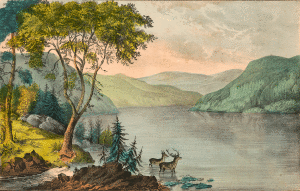

Lake George is without comparison, the most beautiful water I ever saw; formed by a contour of mountains into a basin…finely interspersed with islands, its water limpid as crystal, and the mountain sides covered with rich groves…here and there precipices of rock to checker the scene and save it from monotony. —Thomas Jefferson, May 1791.
Hudson River, Lake George, and Lake Champlain created a waterway connecting New York City, in Britain’s New York Province, to Montreal, in French-Canadian territory. The French and English built garrisons or forts along that inland water route.
Lake George in northeastern New York is 32 miles north-south, almost four miles wide, and up to 200 feet deep. The short La Chute River drops 230 feet from the north of Lake George, as it drains into the southern end of 107-mile-long Lake Champlain.
Lake Champlain, 14 miles at its widest point, lies mainly in Vermont and New York and reaches to St. Johns (Saint-Jean-sur-Richelieu), Quebec, Canada.
In 1734 the French built Fort St. Frédéric on Lake Champlain, some 105 miles south of St. Jean (John).
In 1755 the French built the star Fort Carillon ten miles south of Fort St. Frédéric, where La Chute enters Lake Champlain near northern Lake George. The fort will be the British Ticonderoga.
In 1755 the British built Fort William Henry (40 miles southwest of Fort Carillon) and Fort George (southeast of Fort William Henry) at the southern end of Lake George. The same year the British also built Fort Edward, 15 miles south and a bit east of Fort George, near where the Hudson River veers west.
The French destroyed Fort St. Frédéric in the summer of 1759, before the British army arrived.








I took a guided tour of Fort Ticonderoga one summer. One of the more interesting things was when the guide said it wasn’t the Native Americans or the French the residents of the fort feared the most. It was smallpox.
Louise: Thank you for your comment Matt. My great-great-great-grandfather Asa Hickok reported that he was quite sick, though I’m not sure it was with smallpox. But other sources mentioned that smallpox was a terrible problem. See: http://halfwaybrook.com/?p=8794 and http://halfwaybrook.com/?p=8796
Asa and his family arrived in Lumberland in 1812.